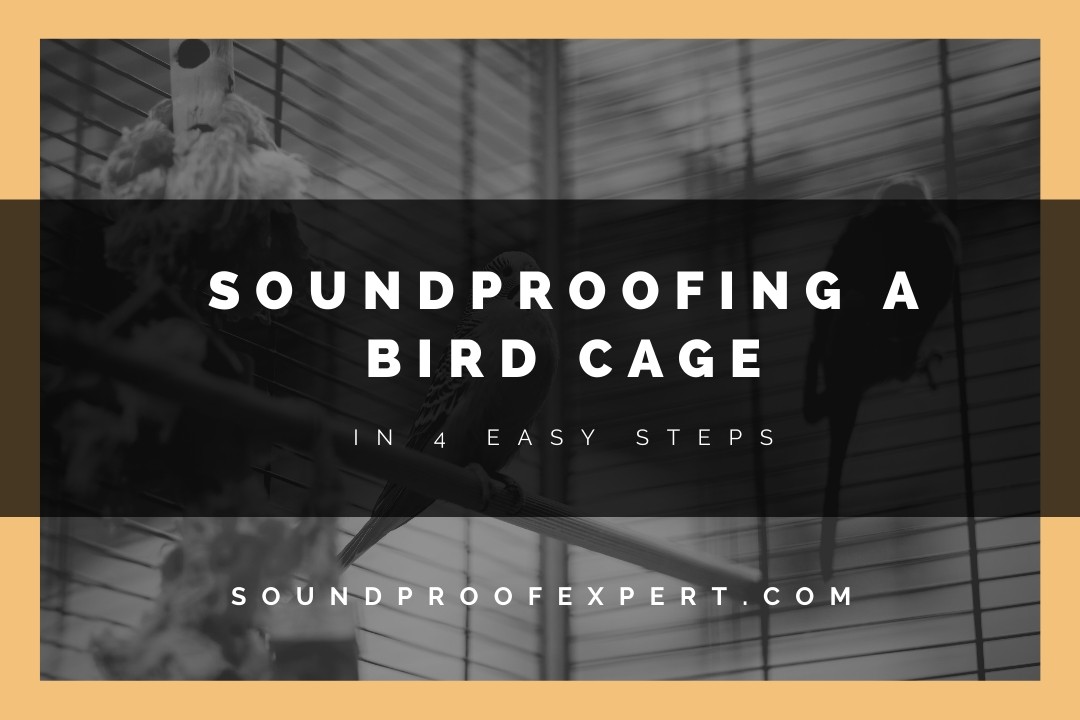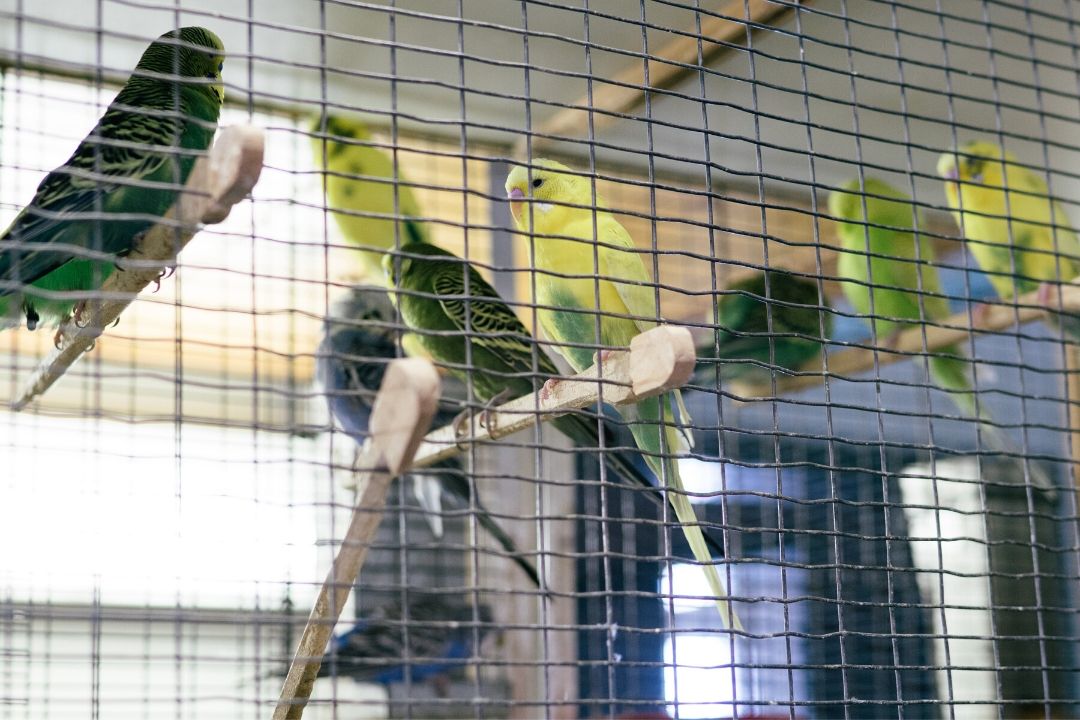
Birds make for clever, funny, and relatively low-maintenance pets. They might also be your best bet if you are allergic to cats and dogs.
The only problem is that birds can be squeaky little devils, making it hard to get a good night’s sleep — which is you may want to look into soundproofing.
So, how do you soundproof a bird cage? Here is a quick step-by-step guide on how to soundproof a bird cage:
- If possible, get an acrylic bird cage.
- Place the cage in a corner and next to a window.
- Attach an acoustic blanket or audio absorption sheets to the back and sides of the cage.
- Use a bird cage cover at night.
That being said, there are a number of other tips and tricks that you can use to reduce bird sounds even further. These include working with your bird to change its behavior, upgrading to a different type of cage, and more.
To get more details on the four steps above and learn about more advanced soundproofing techniques, keep reading.
First Things First: What You Will Need
Depending on which soundproofing option you decide to try and how loud your bird is, you may need some or all of the following:
- Acrylic bird cage, such as this Treetops Small Bird Habitat
- Acoustic blanket or audio absorption sheets, I recommend the Audimute Sound Barrier and Absorption Sheet
- Bird cage cover, such as the Good Night Bird Cage Protector
- Soundproofing panels, such as the Burton Acoustix Series 9
- Soundproof curtains like these Full Blackout Curtains
- White noise machine, such as the Magicteam Sound Machine
- Bird toys, such as this Penn-Plax Bird Life Activity Center
A Quick Note Before We Dive In
People often use the terms soundproofing and sound absorption interchangeably. However, these are two completely different techniques that lead to very different results.
Soundproofing is the process of isolating or blocking sound to keep it from entering or leaving a room.
This is typically done by obstructing the sound’s path with a heavy mass, such as by installing soundproofing panels on the walls or door of a room.
Sound absorption, on the other hand, refers to the use of sound-dampening materials to absorb rather than block noise. That reduces the degree to which sounds amplify, echo, and resonate within a room.
For best results in reducing bird cage noises, you want to use both soundproofing and sound-absorbing materials.
How to Soundproof a Bird Cage: A Step-by-Step Guide
Step 1: Get an Acrylic Bird Cage
If possible, consider upgrading to an acrylic bird cage.
The gaps between the bars of conventional cages are far too wide and allow all sound to pass unhindered.
In contrast, acrylic bird cages come with thick Plexiglas walls that only have tiny holes for ventilation. That helps reduce noise significantly.
Step 2: Place the Cage in a Corner and Next to a Window
If your bird cage is not already placed in a corner, reconsider its positioning. It is going to be much more difficult to block noises coming from a cage in the middle of the room.
If you put it in a corner, however, you would be able to use the walls behind and around the cage to install soundproofing or sound-absorbing materials.
You should also ensure that the cage is near a window. Birds need natural light to stay healthy and thriving. What’s more, providing them with outdoor views and visual stimulation should help keep them calmer — and quieter.
Step 3: Attach an Acoustic Blanket or Audio Absorption Sheets to the Back and Sides of the Cage
After you ensure that the bird cage is placed in an optimal location, cover the back and sides of the cage with an acoustic blanket or audio absorption sheets.
Make sure you don’t cover the front part; your bird needs to have a clear view of its surroundings. It’s also not a good idea to cover the top, as this could block light from entering the cage.
Step 4: Use a Bird Cage Cover at Night
When it’s time for your bird to go to sleep in the evening, place a bird cage cover over the cage and remove it the next morning. A cage cover will not only add an extra layer of insulation but can also keep your bird calmer.
It can also help your bird stay asleep by blocking out any nearby light.
More Tips on Reducing Sound From Your Bird’s Cage
In addition to soundproofing the cage itself, there are a few other things you can do around the room and for your bird to help keep down unwanted noise to a minimum.
Soundproof the Door and Walls of the Room
For optimal results, you may want to consider soundproofing the room the cage is in. One quick and easy way to do that is by installing soundproofing panels directly onto the walls and door.
It is best to invest in high-density panels, as these will help with both soundproofing and sound absorption.
Invest in Sound-Absorbing Soft Furnishings
You can use home decor to both improve the look of your room and reduce unwanted sound.
Soft furnishings such as rugs, fitted carpets, tapestries, cushions, upholstered chairs, or soundproof curtains, can be highly effective at noise absorption.
Remember, they will not block sound but can certainly help prevent it from amplifying and echoing.
Entertain Your Bird

Birds, much like cats and dogs, need plenty of physical exercise, socialization, and mental stimulation.
Therefore, you need to make sure to provide your bird with different toys to play with and change them often. Take the bird outdoors when possible, and, most importantly, do not forget to spend quality time with it every day.
Happy and healthy birds tend to be more relaxed and, therefore, quieter.
Train Your Bird to Be Quiet
If you are prepared to put in the time and effort, you may also try to train your bird to be less noisy. That could work quite well with smarter species such as parrots or parakeets.
The process is fairly simple, but you need to be consistent.
The next time your bird starts screaming, simply walk out of the room. Return only after the bird settles down, and give it a treat. Repeat these steps every time the bird gets into a fit, and, with time, the screaming should subside.
Consider Getting a White Noise Machine
Finally, if nothing else seems to work or your bird is still in training, consider getting a white noise machine. It is not for you, though — it is for the bird.
As strange as it may sound, some birds seem to find white noise relaxing. The machine could also help your bird fall asleep faster.
Alternatively, experiment with playing soft music in the background.
In either case, try different types of white noise and music genres to see which ones work best.
Soundproofing a Bird Cage: Final Thoughts
There are many things you could do to reduce unwanted sounds from your bird’s cage. You can:
- Soundproof the cage
- Soundproof the room it is in
- Work with your bird to manage its behavior and reduce noises
However, you need to remember that, at the end of the day, birds will be birds: they chirp, squeak, and tweet. Some even talk.
That is just something that goes with the turf when you are a bird owner, so make sure to keep your expectations realistic.
